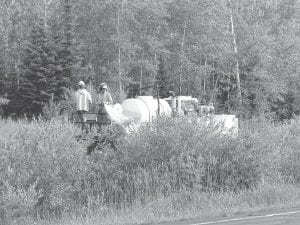Spraying of herbicides for vegetation management on electrical power lines by Great River Energy (GRE) began in Cook County in July and finished up last week. GRE treated its 70 – 100 foot wide transmission line right-ofway from Taconite Harbor in Schroeder to the Maple Hill area. However, unlike the Minnesota Department of Natural Resources (DNR), which posts signs where it uses herbicides or the US Forest Service which issues a press release cautioning the public to be aware that herbicides may be used in forest road rights-of-way, GRE does not notify county residents unless the power lines cross private property.
GRE is a wholesale power provider which delivers electricity to the Lutsenbased Arrowhead Electric Cooperative Inc. Arrowhead Electric has also used herbicides on its distribution power lines in the past. According to Joe Buttweiler of Arrowhead, the last time rights-of-way were treated with herbicide was 2006. Buttweiler said the cooperative subcontracts treatment to companies that are required to use EPAapproved herbicides. The last time Arrowhead used herbicides the work was done by Central Applicators of Foley, MN. Buttweiler said if treatment is to be done, the cooperative notifies its customers via the cooperative newsletter and if the treatment crosses private property, by registered letter.
The Minnesota DNR has not conducted herbicide treatment for several years, however, when it did, in 2007, it did post the area where the spraying took place. The DNR conducted herbicide treatment to eliminate brush to reduce the competition between newly planted trees and brush. The DNR treated 310 acres in 2007 on state land in the Devil Track – Trestle Pine Lake area. The chemical used at that time was Accord, or Glyphosate, which DNR Two Harbors Area Forester John Bachar said was the equivalent of the household weed-killer Round-Up.
The US Forest Service is conducting herbicide treatment along its road rights-ofway in an attempt to control the spread of non-native invasive plants through the end of August. Although Forest Service spokesperson Kris Reichenbach said the Forest Service uses non-chemical means whenever possible, herbicide spraying is often the most effective way to control invasive plants. The Forest Service uses two EPA-approved chemicals, Milestone and Escort.
The Forest Service does not post signs where it sprays, but it sent out news releases cautioning forest visitors not to pick berries next to a road. Reichenbach advised, “Although we control the spray to stay within 25 feet of the road’s edge, we suggest that if you do pick berries next to a road, you move 50 feet from the road before you start picking.”
Maps showing the Forest Service herbicide treatment sites are available at the district offices in Grand Marais, Tofte, Aurora, Ely, and Cook, MN or on the Superior National Forest website at www.fs.fed. us/r9/superior or by calling Jack Greenlee at (218) 229- 8817.
GRE spokesperson Lori Buffington said herbicide treatment is one of many methods the power provider uses to avoid outages on the transmission lines. She explained, “To ensure the safe, reliable operation of our transmission lines, GRE inspects its lines frequently by air and also by ground to look for, among other things, trees that may interfere with lines. Transmission lines are not insulated and their voltage is high, so trees could cause a short circuit and outages. Additionally, line contact with trees or other objects that touch the ground can be dangerous for people nearby and could cause an outage.”
Buffington confirmed website information stating that the transmission line voltage averages 33,000 volts (33kV).
Buffington said GRE contracted with Lake States Tree Service of Grand Rapids, MN, which used Dow herbicides Garlon 3A and DMA4, both EPA approved herbicides. She said the contractor was not required by the EPA to post notice of the spraying.
Approved by the EPA or not, some county residents would rather not see any herbicides used, like Mike Schelmeske, of Grand Marais, who noticed the spraying operation on County Road 7 in Grand Marais—in an area abundant with raspberry bushes. Schelmeske said he would prefer mechanical brush clearing. “If they contacted people, they may find that we’d be willing to mechanically release the vegetation,” said Schelmeske.
Schelmeske noted that at the very least, GRE could post signs informing the public that chemical treatment had taken place within the right-of-way. “Then people would know that the area had been sprayed and someone who was chemically sensitive would have the option of going elsewhere to walk or to pick berries.”
Steve Scott, general foreman with Lake States Tree Service, said his company does contact land-owners if the treatment is conducted on easements crossing private property. He said the county property tax roll is used to contact people and before any spraying is done, a person in the field double-checks to see that they have found all landowners on the transmission line.
No notice is given on road rights-of-way owned by the county or state. Scott said land use permits have been obtained for maintenance work, including herbicide treatment on the power line rights-of-way along roads. Posting is not required with the herbicides in question, he said. “If the label requires posting, we do post. The label is the law,” said Scott.
Scott said that the Dow chemicals used are approved for use in working pastures (except dairy) and in wetlands. “Apparently there is not a significant risk to people’s health,” said Scott.
Asked if posting would be considered in the future, Scott said his company would not post unless directed by the EPA or GRE. “Every year we probably spray at least 1,000 miles of right-of-way throughout the state,” said Scott. “If we had to post it all, it would become very costly.”
Scott confirmed that the herbicide treatments in Cook County were finished. “By this time everything we sprayed is definitely wilting,” he said.



Loading Comments